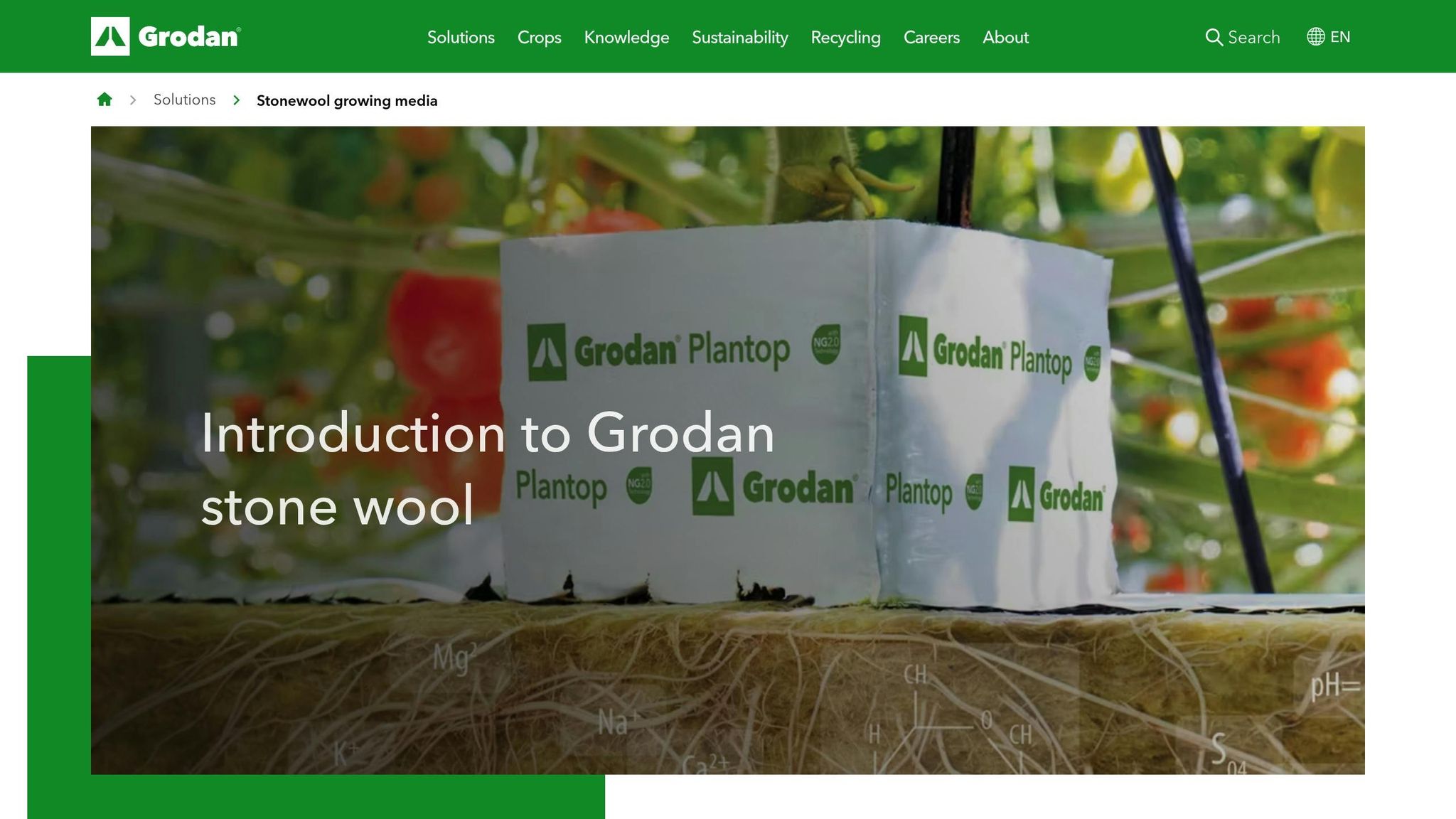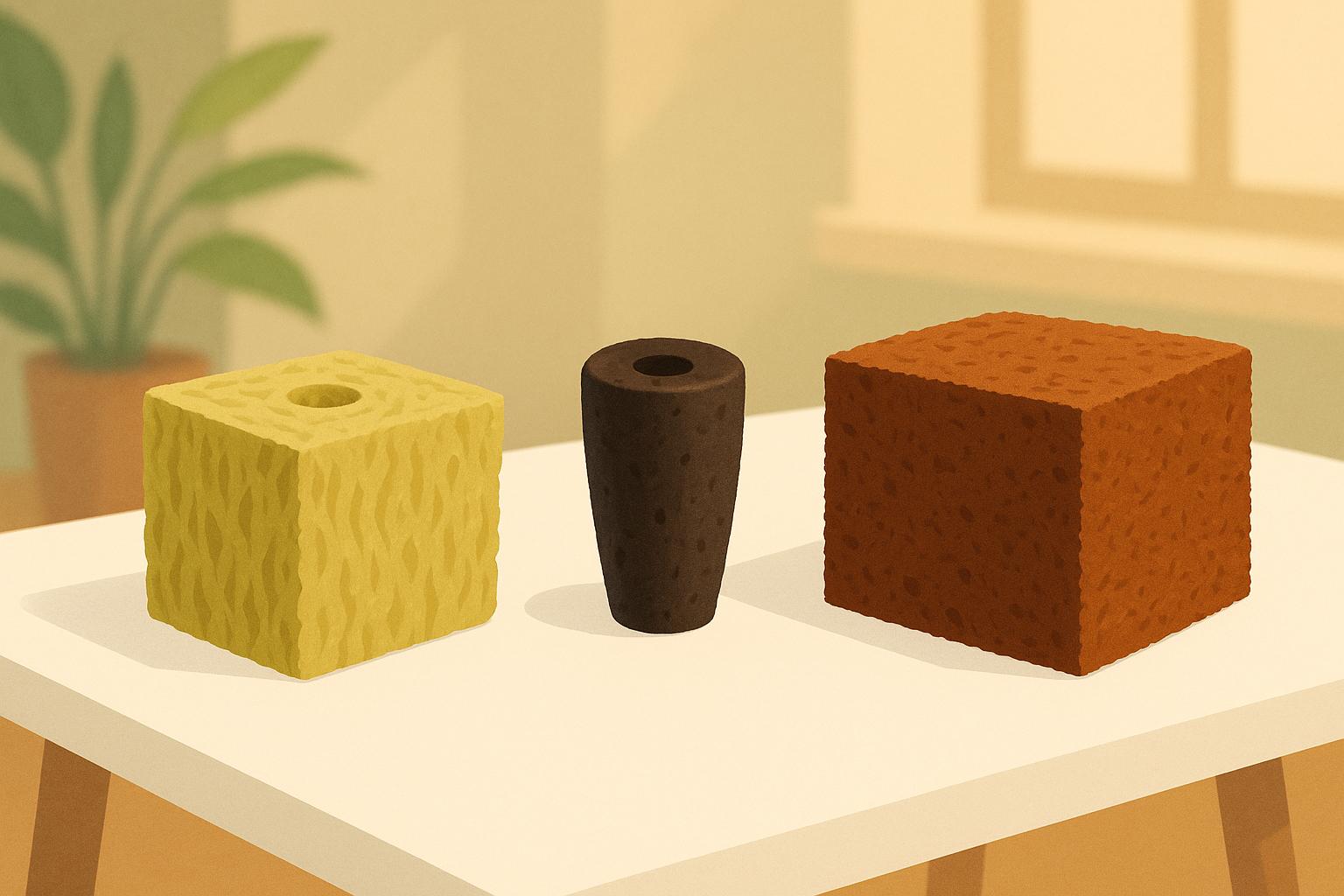Best Seed-Starting Mediums for Hydroponics: Rockwool, Rapid Rooters & Coco Coco
Choosing the right seed-starting medium is crucial for hydroponic gardening success in Australia. Here's a quick breakdown of the top three options - Rockwool, Rapid Rooters, and Coco Coir - to help you decide:
- Rockwool: Excellent water retention and aeration. Ideal for strong root growth but requires pH adjustment and has a high environmental impact.
- Rapid Rooters: Ready-to-use plugs with balanced moisture and airflow. Made from sphagnum peat moss with a neutral pH, they're biodegradable but less durable than the other options.
- Coco Coir: Fully organic and biodegradable, it offers excellent water retention and aeration. Requires soaking before use but is eco-friendly and versatile across systems.
Quick Comparison
| Feature | Rockwool | Rapid Rooters | Coco Coir |
|---|---|---|---|
| Water Retention | Excellent | Good | Excellent |
| Aeration | High porosity | Balanced | Excellent |
| pH Level | Slightly alkaline | Neutral | Neutral |
| Environmental Impact | Non-renewable, energy-intensive | Biodegradable | Fully renewable, biodegradable |
| Preparation Needed | Requires pH adjustment | Ready to use | Requires soaking |
For beginners, Coco Coir is a great starting point due to its ease of use and eco-friendliness. Advanced growers can refine their choice based on their hydroponic system and local climate. Dive into the article for detailed guidance on each medium!
Which Grow Medium Works Best For Germinating? Seed ...
1. Rockwool Properties

Rockwool stands out as a reliable medium for hydroponic seed starting, thanks to its unique structure. When properly prepared, it consistently maintains a nutrient, air, and fibre balance of 80/15/5.
Efficient Water Management
With a porosity of up to 96%, rockwool allows for precise moisture control. A typical slab can hold as much as 15 litres of water, creating a substantial reservoir for seedlings while ensuring proper aeration. This balance of water and air supports healthy root development.
Encourages Root Growth
Rockwool's moisture gradient, which leaves the upper layers drier, promotes strong root systems. Studies show a 70% germination rate when using rockwool, compared to 50% with cotton or sponge substrates. Its fibres form channels that encourage root expansion and maintain consistent oxygen levels.
"The primary reason for using rockwool, or any substrate, in a hydroponic growing system is to provide a buffering reservoir of nutrient solution in the root zone while maintaining an adequate volume of air (oxygen) in contact with the roots."
– Michael F. Dowgert Ph.D., Research Manager, Agro Dynamics
Environmental Impact
While rockwool excels in plant growth, its production has environmental challenges. Manufacturing involves heating chalk and rock to around 1,650°C, requiring significant energy. Its durability allows for reuse across growing seasons, but this same toughness means it doesn't decompose in landfills.
Tips for Using Rockwool
To make the most of rockwool, follow these practical guidelines:
- Use short, frequent irrigation cycles to maintain optimal moisture levels.
- Ensure proper drainage to improve airflow within the medium.
- Avoid compressing the material, as this can damage its structure.
- Keep a close eye on moisture levels; plants won't show water stress until the medium is nearly dry.
| Property | Specification |
|---|---|
| Porosity | Up to 96% |
| Solution Content | 80% |
| Air Space | 15% |
| Fibre Content | 5% |
| Standard Slab Capacity | 15L |
Rockwool is a reliable choice for hydroponic systems, offering excellent support for plant growth.
2. Rapid Rooters Features
Rapid Rooters, made by General Hydroponics, are popular starter plugs designed to simplify hydroponic seed starting. They strike a balance between holding moisture and allowing airflow, which is crucial for healthy seedling development in hydroponic systems. These plugs combine natural materials with a design tailored to meet the needs of hydroponic growers.
Efficient Moisture Retention
Rapid Rooters are great at holding water while still allowing enough airflow to encourage quick germination and strong root growth. Made primarily from sphagnum peat moss, they maintain consistent moisture levels and resist compacting, which helps seedlings thrive.
Neutral pH for Easy Use
These plugs come with a neutral pH, so there's no need for pre-treatment. This saves time and reduces the risk of pH-related problems during early seedling growth.
Built-In Biological Advantages
Rapid Rooters provide several natural benefits, including:
- Trace nutrients and minerals
- Beneficial microorganisms
- Biodegradable materials
- Compatibility with organic growing systems
Cost and Durability
A pack of 50 plugs typically costs between AUD $14.99 and $23.99. Thanks to their sturdy structure, they can be placed directly into various hydroponic systems without falling apart.
| Feature | Specification |
|---|---|
| Base Material | Sphagnum peat moss |
| Binder Type | Plant-based foam |
| pH Level | Neutral |
| Pre-treatment Needed | No |
| System Compatibility | Hydroponics, Aeroponics, Soil |
How to Use Rapid Rooters
These plugs are easy to work with in different hydroponic setups. For best results:
- Pre-soak them in water or a diluted nutrient solution
- Ensure only the bottom touches water
- Use grow trays for stability
- Keep moisture levels in check
With their user-friendly design and adaptability, Rapid Rooters are a reliable choice for starting seeds in hydroponic systems. They offer a practical solution for gardeners looking for an effective seed-starting medium.
3. Coco Coir Characteristics
Coco coir, sourced from coconut husks, is a reliable medium for hydroponic seed starting. Its ability to balance water retention and aeration makes it a strong option for growers.
Water Retention and Aeration
Coco coir is made up of coconut pith, fibre, and chips. The pith absorbs water like a sponge - holding up to eight times its weight - while the fibre and chips ensure proper aeration. This creates a 70:30 moisture-to-air ratio, which helps prevent overwatering and reduces the need for constant maintenance.
Structural Advantages
When hydrated, coco coir expands up to eight times its dry volume while maintaining excellent aeration. This structure supports strong root growth and healthy seedlings.
| Property | Specification |
|---|---|
| pH Range | 6.0–6.8 |
| Water Retention | Up to 8× its weight |
| Volume Expansion | Up to 8× when wet |
| Moisture-to-Air Ratio | 70:30 |
| Environmental Impact | 100% organic & biodegradable |
Preparation Steps
- Soak the coco coir in water for 24–48 hours and rinse thoroughly to remove salts and impurities.
- Blend with perlite or vermiculite to improve structure.
- Add a layer of clay pebbles at the bottom of pots to enhance drainage.
Environmental Benefits
Coco coir is fully organic and biodegradable. As Coco House Australia states:
"Our mission is to support the agricultural and horticultural industry by promoting sustainable environments. All of our products are 100% organic and completely biodegradable with no adverse effects to the environment."
Versatility Across Systems
Coco coir suits a variety of hydroponic setups, from passive to active systems. It also provides an excellent surface for beneficial bacteria to grow, making it a great choice for aquaponic systems. These qualities make it a practical and eco-conscious option for many hydroponic growers.
Coco coir's eco-friendly nature and practical benefits make it an excellent choice for those looking to optimise their hydroponic systems.
Medium Comparison Chart
Here's a quick look at how these growing mediums stack up against each other. The table below provides an easy-to-digest comparison.
| Characteristic | Rockwool | Rapid Rooters | Coco Coir |
|---|---|---|---|
| Water Retention | Excellent | Good | Excellent |
| Aeration | High porosity | Balanced | Excellent |
| pH Level | Slightly alkaline | Neutral | Neutral |
| Environmental Impact | Non-renewable, energy-intensive | – | Renewable, biodegradable |
| Preparation Required | Requires pH adjustment | Ready to use | Requires soaking |
Key Performance Metrics
| Performance Aspect | Rockwool | Rapid Rooters | Coco Coir |
|---|---|---|---|
| Root Development | Excellent | Good | Excellent |
| Nutrient Retention | Low CEC | – | High CEC |
Environmental Considerations
| Environmental Factor | Rockwool | Rapid Rooters | Coco Coir |
|---|---|---|---|
| Carbon Footprint | High | – | Low |
| Resource Renewability | Non-renewable | – | Fully renewable |
| Disposal Impact | Non-biodegradable | – | Fully biodegradable |
| Production Energy Use | High energy use | – | Low |
Best Medium Selection Guide
Selecting the right growing medium for your hydroponic setup is crucial, especially when factoring in Australia's unique conditions. This guide breaks down options for beginners, system-specific setups, and advanced techniques.
For Beginners
Coco coir is a great starting point. It has a neutral pH, resists fungi, and retains moisture well. For the best results, mix 70% coco coir with 30% perlite. This combination provides excellent aeration and hydration.
System-Specific Recommendations
| System Type | Ideal Medium | Key Benefits |
|---|---|---|
| NFT Systems | Rockwool | Stable and inert, ideal for root development |
| Deep Water Culture | Coco Coir | Balances moisture and provides good aeration |
| Drip Systems | Coco/Perlite Mix | Ensures proper drainage and moisture retention |
Climate Considerations
Australia's diverse climate plays a big role in medium selection. In humid areas like tropical North Queensland, focus on aeration. A coco coir and perlite mix works well to improve drainage while maintaining moisture levels. For drier regions like South Australia, adding vermiculite can help retain water.
Advanced Gardener Tips
For those with more experience, fine-tuning your medium can yield better results:
- Water-sensitive plants: Increase the perlite ratio to improve drainage.
- Heavy-feeding crops: Coco coir is ideal due to its high cation exchange capacity (CEC).
- pH-sensitive crops: Use pre-buffered coco coir to ensure stable nutrient levels.
- Eco-conscious growers: Coco coir is a more sustainable choice compared to Rockwool, which requires energy-intensive production.
These tips, combined with earlier performance insights, can help you match your medium to your hydroponic system and local conditions for optimal results.
FAQs
What are the environmental impacts of Rockwool in hydroponics, and are there eco-friendly alternatives?
Rockwool has significant environmental drawbacks. It is non-biodegradable, meaning it can accumulate in landfills, and its production involves high energy use, often relying on non-renewable resources. Additionally, loose fibres from Rockwool may pose risks to soil, wildlife, and human health.
For more sustainable options, consider coconut coir, peat, or sphagnum moss. These organic materials are biodegradable, environmentally friendly, and provide excellent water retention and aeration for hydroponic systems. They offer a greener and more sustainable alternative to Rockwool.
How do I prepare coco coir for hydroponics, and why should I mix it with perlite?
To prepare coco coir for hydroponics, start by soaking it in water to allow it to expand fully, then drain any excess water. For best results, buffer the coir with a calcium-magnesium solution to stabilise the pH, aiming for a range of 5.5 to 6.5. Once prepared, you can add nutrients using slow-release fertilisers, nutrient solutions, or organic options to support healthy plant growth.
Mixing coco coir with perlite is a great way to improve drainage and aeration around the roots, which helps prevent overwatering and promotes strong, healthy plants. This combination is especially effective for hydroponic systems where maintaining an ideal balance of moisture and oxygen is key.
Why are Rapid Rooters a good choice for beginners starting seeds in hydroponics?
Rapid Rooters are an excellent option for beginners because they are ready-to-use and don't require time-consuming pH adjustments, unlike some other mediums. These pre-made plugs simplify the seed-starting process, making them ideal for those new to hydroponic gardening.
They provide an optimal balance of water retention and airflow, creating a supportive environment for seed germination and early root development. Additionally, their design helps minimise the risk of root rot, giving your plants a healthy start with minimal effort. Perfect for beginners looking for a hassle-free solution!
Related posts
- Best Hydroponic Media for Medicinal Herbs
- Best Hydroponic Media for Tomatoes
- Coconut Coir: Uses in Hydroponics
- 5 Best Hydroponic Growing Media for Water Retention

